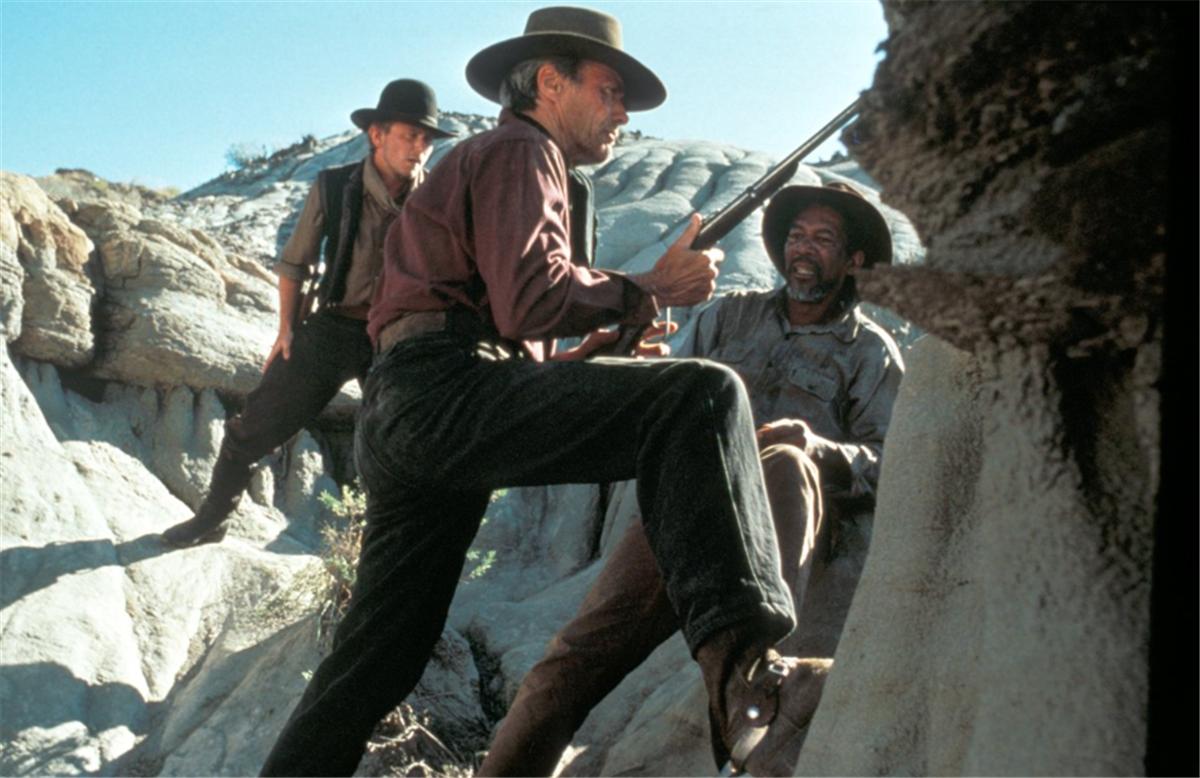Few actors stand out as prominently in their genre as Clint Eastwood does in the Hollywood Western. The actor-turned-filmmaker got his big break starring as Rowdy Yates on the long-running series Rawhide before graduating to the Spaghetti Westerns of the 1960s and ’70s. Then, in 1992, Eastwood retired from his familiar genre with a magnificent sendoff in 1992’s Unforgiven, where he played aged gunfighter and outlaw William Munny. But aside from the genre itself, not to mention Eastwood’s involvement, there’s another major connection between the beginning and end of Clint Eastwood’s career in the Western: his cowboy boots.
Clint Eastwood Wears Some Familiar Boots in ‘Unforgiven’

If you look closely at Clint Eastwood’s trademark look in Unforgiven, you’ll recognize something familiar the further down your gaze moves. Boots may not be what makes the man, but in Eastwood’s case, they stuck with him throughout his illustrious Western career. While we aren’t always able to make out Rowdy Yates’ boots in the black-and-white series Rawhide, behind-the-scenes images (such as this one) show the clear style of Eastwood’s boots. These cowboy kicks are tan-ish in color, spurred, and sport a belted clasp on the front. While Eastwood often wore them under his pant legs, other images prove that they run all the way up to his calves. When compared with Eastwood’s wardrobe from Unforgiven, it’s clear that William Munny and Rowdy Yates share the same cobbler. You can even see the boots a bit better on the recently revealed William Munny figure.
Thematically, Unforgiven was already meant to be Eastwood’s clear-cut sendoff to the genre, which had launched his career decades prior. After starring in fourteen Westerns (and directing three of them), Eastwood planned Unforgiven as his finale in advance. No doubt, his boots were handpicked as a tributary farewell to the genre, which began with his work on Rawhide. While he doesn’t wear them the entire picture (early on, he’s retired from gunfighting, and wearing his trademark cowboy boots too, apparently), once William Munny springs back into action, they’re back on his feet. In 2005, these same boots were displayed in the “Once Upon a Time in Italy…The Westerns of Sergio Leone” exhibit at The Gene Autry Museum of the American West in Los Angeles (as noted by the Saskatchewan Science Center), which likewise explained the connection. But why would these books find their way into an exhibit all about director Sergio Leone? Well, it turns out that these boots were well-known for their work in other Westerns too.
Just before Rawhide went off the air, Eastwood teamed up with Leone for a Western called A Fistful of Dollars. His infamous “Man With No Name” character eventually returned in 1965’s A Few Dollars More, and again the next year in his trademark picture, The Good, the Bad, and the Ugly. In all three instances, Eastwood sports the same style of footwear, easily recognizable here in full color. “Eastwood wears the same cowboy boots that he wore as Rowdy Yates on Rawhide,” men’s fashion site BAMF Style noted in 2020. “Though the color cinematography of Leone’s Dollars trilogy allowed viewers to see the rich medium tan color of the roughout cowhide for the first time.” It seems that Eastwood had some personal affection for these boots, so it’s no wonder he put them back on again for his final Western outing.
‘Unforgiven’ Was a Strong End to Clint Eastwood’s Western Career

Though Sergio Leone’s Dollars trilogy of Spaghetti Westerns was likely a contributing factor, it was Rawhide that first launched Clint Eastwood into the Hollywood spotlight. On the show, Eastwood’s Rowdy Yates worked alongside Gil Favor (Eric Fleming) to drive cattle all across the American West. At first, Rowdy was just like you’d expect from someone with that name, but over time, Favor helped turn the young man into a leader on his own. By the time Fleming left the show ahead of its eighth and final season, Rowdy was upgraded from ramrod to trailboss and carried the remaining thirteen episodes.
Just ahead of the show’s seventh season is when Eastwood tackled his first major Western motion picture (despite having appeared in three other film Westerns in the mid-1950s). The Dollars trilogy was a hit for the actor, who continued to make Westerns like Hang ‘Em High and Paint Your Wagon. Then the ’70s came around, and Eastwood became as interested in directing as he was in acting, debuting with Play Misty For Me in 1971, which he also starred in opposite future Arrested Development star Jessica Walter. It wasn’t long before Eastwood combined these loves though, directing and starring in pictures like High Plains Drifter, The Outlaw Josey Wales, and Pale Rider (the last one being his only Western of the 1980s).
So, when it came time to tackle Unforgiven, Eastwood was ready to say goodbye to the genre after 217 episodes of Rawhide and over a dozen Western features. Of course, Unforgiven shows off the best the genre has to offer, and showcases Eastwood’s chops as both an actor and a director. More than that, the screenplay by David Webb Peoples is practically flawless, a perfect choice for Eastwood to tackle in his official retirement from the genre. No wonder it walked away (or, rather, rode away into the distance) with four Academy Awards in its holster. However, just because Eastwood left the traditional Western behind doesn’t mean that he’s left some of the trademarks of the genre along with it. Revising the American West and the mythic themes of the genre in films like The Mule and Cry Macho, it’s clear that Eastwood still loves the Western, even if he’s retired from making them himself.
